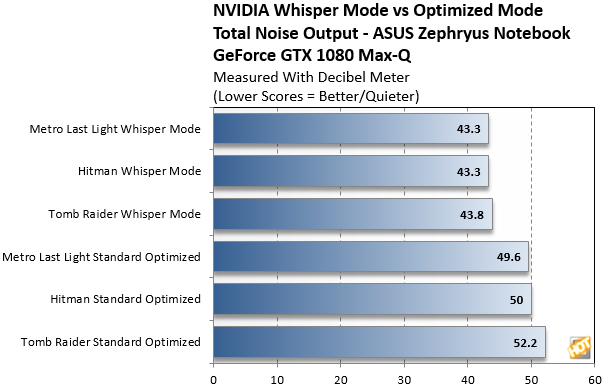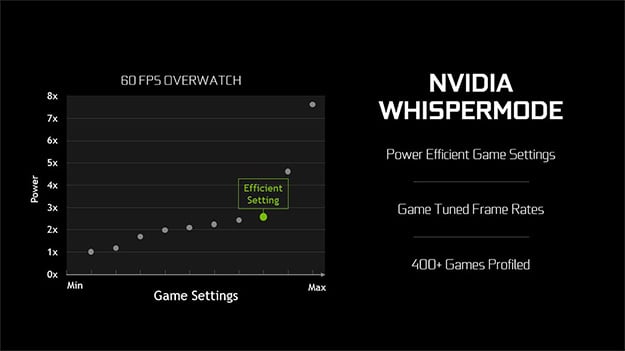NVIDIA's Whisper Mode For GeForce-Powered Gaming Laptops Put To The Test
A new feature of NVIDIA's latest GeForce technology for laptops that we weren't able to evaluate until now, is something NVIDIA calls Whisper Mode. Like its recently introduced Max-Q technology that paves the way for thinner and lighter gaming laptops such as the ASUS ROG Zephyrus GX501, Whisper Mode is another type of mobile gaming optimization, except it focuses on noise output with the intrinsic benefit of lower power draw as well. Short and to the point, it is an intelligent framerate pacing technology designed to lower GPU power consumption, utilization, and ultimately fan noise, while still delivering a smooth and playable gaming experience.
"To determine WhisperMode settings we measure GPU power consumption at various detail levels in games, looking for the most efficient high-quality settings. For example, as you increase the graphics settings in Overwatch, power consumption and GPU utilization increase. At a certain point, cranking up graphics settings higher results in significantly more power consumption, causing fans to spin ever faster, and acoustics to worsen," NVIDIA explains.
NVIDIA says it has profiled the top 400 games and found the sweet spot between game settings and GPU power consumption for each one of them. Based on those metrics, Whisper Mode adjusts settings accordingly, and you end up with a playable experience on a laptop that runs cooler and quieter than it otherwise would have, with minimal sacrifice in image quality. For fast-paced competitive games, like Overwatch and League of Legends, the frame rate limit is set at 60 frames per second. And for graphically demanding titles such as Tom Clancy's Ghost Recon Wildlands and The Witcher 3, Whisper Mode caps gameplay at 40 fps.
That is how Whisper Mode works in theory. Does it work in practice? We were determined to find out, so we tested Whisper Mode on a handful of games using the aforementioned Zephyrus GX501. To recap, this an impressive powerhouse that pairs an Intel Core i7-7700HQ processor with an NVIDIA GeForce GTX 1080 Max-Q graphics engine. It also boasts 16GB of DDR4-2400 RAM, a 512GB Samsung SM961 NVMe solid state drive, and Windows 10 Home 64-bit. All of this goodness comes packed inside a thin and light chassis measuring a mere 0.67-0.7 inches at the waistline, and weighing just 4.85 pounds.
While not quite ultrabook territory in terms of weight, it is nearly 3 pounds lighter than the Alienware 15, which also offers the GeForce GTX 1080 (full fat) as an option. And as further points of reference, Clevo and Razer offer 15.6-inch notebooks with NVIDIA GeForce GTX 10 series graphics at 5.5 pounds, but the options top out with the GTX 1070. Both systems also exhibit higher a level of fan whine.

We tested Whisper Mode with three games: Metro Last Light, Tomb Raider, and Hitman: Absolution. Each one was benchmarked with Whisper Mode engaged and compared with the results from benchmarking with standard "Optimized Performance" modes enabled. As you can see above, there is a noticeable drop in noise output. All three games hovered around 50 decibels without Whisper Mode, with Tomb Raider ramping up to 52.2 dBA, which is around the noise level of light traffic or a running refrigerator. The American Speech-Langauge-Hearing Association (ASHA) describes 50 dBA as being equivalent to a moderate rainfall.
In Whisper Mode, the noise levels dropped to below 44 dBA, as measured by our handy Dr. Meter. At this level, the noise is comparable to the ambient noise of a suburban area at night. ASHA likens 40 dBA to a "quiet room."

In order to drop noise levels by several decibels, Whisper Mode caps performance. In all three games, the cap was set at 40 fps, and as you can see that is exactly what we averaged. Raw framerates were essentially halved from running the laptop without Whisper Mode engaged.
Cutting framerates in half may sound severe, but what is important to note here is that this laptop has plenty of GPU power to spare. By capping things at 40 fps, we still end up with a smooth gaming experience, but with the added benefits of running cooler and quieter, and presumably giving us longer battery life to boot, though we're still testing on that front.
Another thing we saw with Whisper Mode engaged was more consistent framerates. The graph on the left shows framerates going on a roller coaster ride when running Optimized Performance mode. Over on the right we see that framerates are VERY stable and flat in Whisper Mode, providing a good gaming experience while conserving power and reducing noise. And just as importantly, there are no dips into unplayable territory.
What About Power Draw?
The last thing we want to talk about here is power draw. In Tomb Raider, we measured a peak power draw of 170 watts when running in Optimized Performance mode. This dropped all the way down to 103 watts in Whisper Mode, which is also a peak measurement. The average power draw was around 155 watts in Optimized Performance mode and 90 watts in Whisper Mode. We do not have battery life figures to share just yet, but those kinds of drops in power consumption will undoubtedly yield longer overall run times when gaming.Our takeaway from all of this is that Whisper Mode works as advertised. For systems with GPU horsepower to spare, Whisper Mode seems to be a great way of lessening the strain on the GPU, resulting in less heat, lower noise, longer battery life, and perhaps even a longer lifespan. And it achieves all this without adversely affecting real-world gaming performance, so long as you have the perf to spare.





